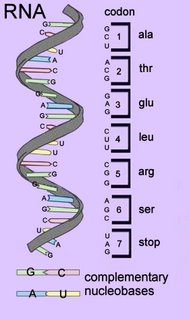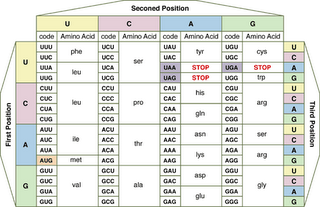 In the centre of the DNA double helix each nucleobase (base) is hydrogen bonded to its complementary base – because of steric (size) constraints, purines bases pair with pyrimidine bases. A with T, and C with G.
In the centre of the DNA double helix each nucleobase (base) is hydrogen bonded to its complementary base – because of steric (size) constraints, purines bases pair with pyrimidine bases. A with T, and C with G.RNA molecules are created by transcription from the archival DNA template. Like replication, transcription proceeds 3' to 5' on the template strand and 5' to 3' on the RNA strand. Proteins are synthesized from the amino acid terminus to the carboxyl terminus by formation of peptide bonds between amino acids delivered by tRNA anticodons.
Because the nucleotide triplet sequences would produce different amino acids if ‘reading frames’ commenced at the wrong nucleotide, codons in genes are read in reading frames that commence at the start codon – usually the first AUG in the RNA sequence (ATG triplet for DNA). AUG also codes for the amino acid methionine.
 The RNA code is at left (click to enlarge). In accord with its origin early in evolution, the genetic code is almost universal – with only a few organisms employing variants.
The RNA code is at left (click to enlarge). In accord with its origin early in evolution, the genetic code is almost universal – with only a few organisms employing variants.Each tri-nucleotide in the DNA sequence and transcribed mRNA codon signals for the insertion of one amino acid into a polymerizing peptide chain. The sequence of codons in genes determines the sequence of amino acids inserted into peptide, polypeptide and protein chains (primary structure).
In general, a consensus sequence is that idealized sequence in which each position represents the base/amino acid most often found when many sequences are compared. A genetic consensus sequence is a sequence of nucleotides that is common to different genes or genomes. There may be some variations but such sequences show considerable similarity. So, a consensus sequence is the prototype sequence that most others approach.
Take an interactive peek at a sequence of DNA around the gene cyclooxygenase 2: PBS Cracking the Code of Life : Find on/off : Find start : Find stop : Find exons : Find introns : Find transposable elements : Find conserved DNA : Find single nucleotide polymorphisms : Find gene and scroll down:
▲ Top ▲
No comments:
Post a Comment